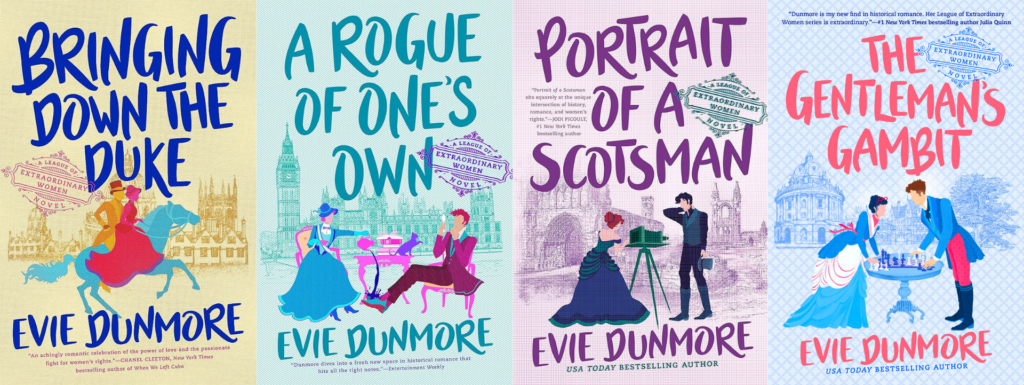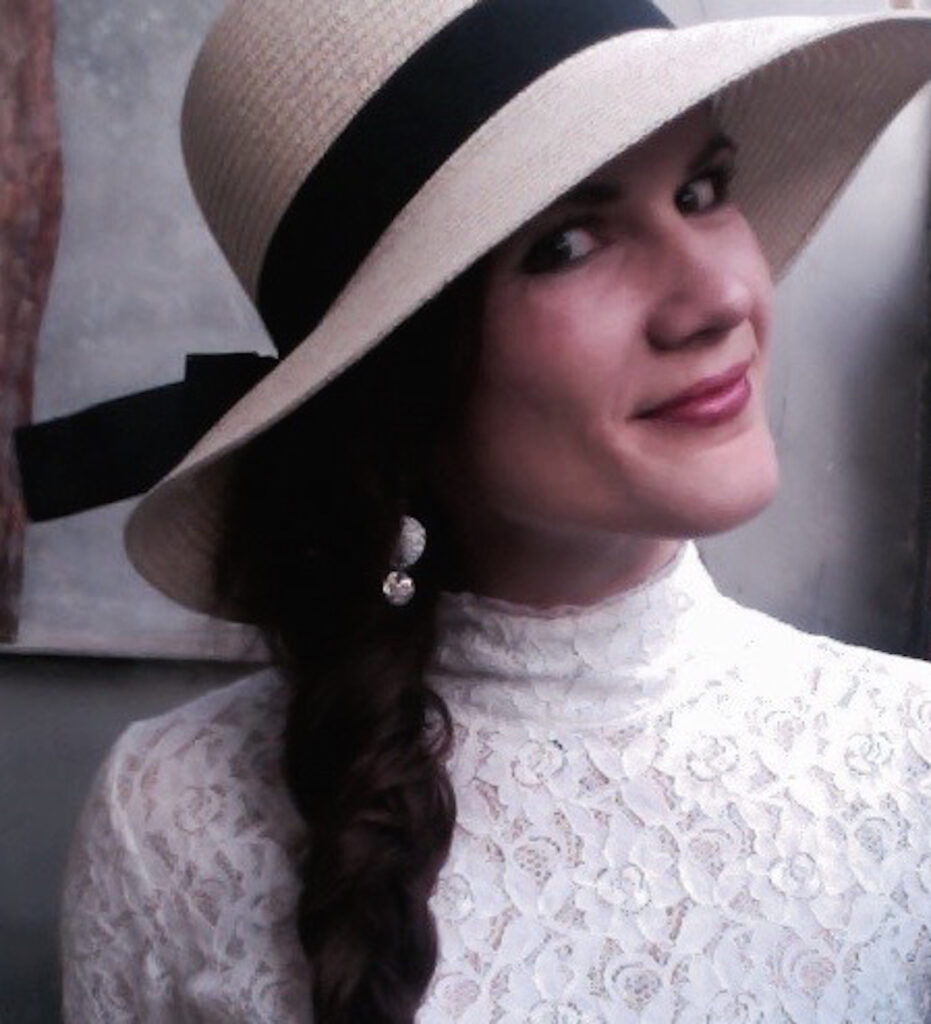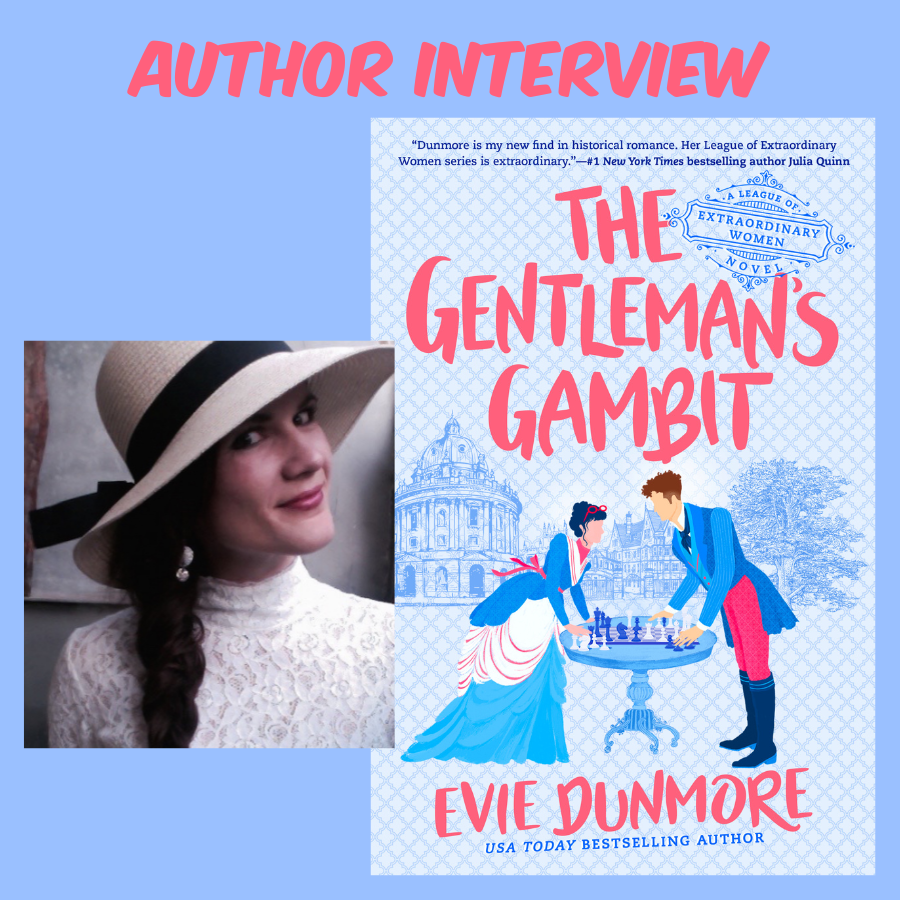This post may include affiliate links, which means we make a small commission on any sales. This commission helps Feminist Book Club pay our contributors, so thanks for supporting small, independent media!
A League of Extraordinary Women begins with Annabelle’s story in Bringing Down the Duke. I had first picked up this book at the beginning of COVID-19. This was a time of high stress (who didn’t have a little anxiety?) and very little sleep. For this reason, I read Bringing Down the Duke in one sitting (that sitting took place between 10 p.m. and sunrise – who else is nocturnal?). The following books, A Rogue of One’s Own, Portrait of a Scotsman, and The Gentleman’s Gambit, follow the lives of Lucie, Hattie, and Catriona. These women are amongst the first females to attend Oxford University and have their own roles championing women’s rights in the suffrage movement in the late 1800s in England. These characters, their stories, and Dunmore’s writing will always have a special place in my heart. If you’re looking for feminist, historical romances that will also put you in your feelings, make sure to add A League of Extraordinary Women to your To Be Read (TBR).
Below is a conversation I was able to have with Evie about these extraordinary women.

What inspired you to write about the women in A League of Extraordinary Women?
The series began as a love story. The first characters I heard were Annabelle and Sebastian from the first novel, Bringing Down the Duke, and their love couldn’t be due to class differences. I love happy endings though, so I decided to write these two a romance. It dawned on me then that the traditional “happy ending”, namely, marriage, wasn’t very romantic in the context of Victorian England. Women lost their legal personhood as well as their right to property after marriage and property was a pre-qualification for the right to vote, too. I felt I had two choices if I wanted to go ahead and set a romance in that environment: ignore these realities, or work with them. I decided to make the heroines women’s rights activists. Exploring romantic love within those constraints was interesting. One of the first things I researched were the marriages or relationships (there were suffragists who “lived in sin”) of suffragists and I realized that it was a historically plausible storyline – but the women had to marry an ally. So I set out to find matches for unconventional women.
Why did you decide to write about the suffragist movement specifically in England during the 1800s?
Annabelle was an early Oxford University student before I decided that she was also a women’s rights activist, so that tied me to the 1880s. The late 19th century is an exciting period, where economic, technological, and socio-political developments that still inform our lives today were really picking up steam. There were movements for animal rights, children’s welfare, labour unions, women’s rights…. I found it important to know the history of these movements as to not repeat mistakes and to understand things within context. The quest for women’s rights is still ongoing and as recent developments in the US show, gains can be reversed. We can’t ever take things for granted.
What can we learn from the first women who attended Oxford University?
That it pays to stand up for your needs and desires and to be tenacious in the face of opposition, but also, that it can also take a long time to get your rights. You don’t get a place at the table without a basic education, and more options open up with higher education. At the time, people wanted to deny women higher education; after Oxford admitted the first class of women in 1879, it should take almost another 40 years until female students at Oxford were allowed to matriculate and graduate just like the male students. The female students and tutors had heard it all, that their studies would make them barren or would give them nervous breakdowns, that they would remain spinsters, that it would ruin the social order, that it would turn them away from their true purpose which was caring for others. Collectively, the women just shrugged it off. More female students enrolled every year and once they were allowed to sit exams with men, they began beating them in the grade department, too. Their urge to exercise their minds and to discover a whole world beyond the domestic sphere won out in the end. That said, not all women in support of higher education were also in support of a woman’s right to vote. As always, these situations were never black and white.
Which of the four women that you have written about (Annabelle, Lucie, Hattie, or Catriona), do you relate to the most, and why?
I’m not really like my main characters, they are constructs, though each of them probably reflects one of my traits or experiences within their own context. People close to me say I have things in common with Catriona.
What are some important characteristics of the league of extraordinary women that we can learn from today?
To accept each other despite your differences – each of the girls in the quartet has a different approach to love, the Cause, and how they tackle problems. They have a great friendship regardless and use their different facets to form a great team and to contribute to the cause in different ways. They did this during a time when women were raised to compete over the resource “man”. They understood that the system was rotten, so they took the long view and worked together to change that instead of going for the quick prize. Personally, I’ve always loved and cherished my women friendships and finding female mentors is also something I value a lot so I hope I can be that person for other women.
When writing about the women’s love interests, how was it finding the balance between a man of their time and a man who would be supportive of their beliefs and endeavors?
There are plenty of real-life examples of 19th men who supported their unconventional spouses, so I didn’t have to invent a fantasy man. We are looking at the husbands of e.g. Millicent Fawcett and Emmeline Pankurst who admired and supported their wives and fought for the cause. Elizabeth Wolstonholme Elmy’s husband, Ben Elmy, was a feminist and accepted her wish to live “free love” because she didn’t want to get married (they did marry when she became pregnant out of wedlock and was pressured by fellow suffragists). Lord Selborne, the man who inspired the character of Sebastian, Duke of Montgomery, pushed the amendment of the married Women’s Property Act through Parliament while he was suffering grave health problems that should have kept him home. Men founded the “Men for Women’s Suffrage League”, lobbied parliament, went to prison, were force-fed. The most unlikely aspect about my heroes is how conventionally attractive they all are, but their mindsets weren’t much of a stretch.

Evie Dunmore wrote her USA Today bestselling series inspired by the magical scenery of Oxford and her passion for romance, women pioneers, and all things Victorian. In her civilian life, she is a consultant with a M.Sc. in diplomacy from Oxford. Evie lives in Berlin and pours her fascination with nineteenth-century Britain into her writing. Learn more online at www.eviedunmore.com.


![Pride month is coming to an end and we're turning the chapter on our June theme: Be Gay, Do Crime 🏳️🌈 We spent the month with six different books, reading in community, and gave away some pretty cool titles in the online community.
This July we'll be diving into Disability Justice, but for now let's focus on the present.
What books did you read during Pride Month? 📚️
[alt text: an assortment of books by lgbtqia+ authors and feature lgbtqia+ stories arranged face up on a flat surface]
#bookstagram #pridebooks #lgbtq #bookclub #bookcommunity #feministbookc.ub](https://www.feministbookclub.com/wp-content/plugins/instagram-feed/img/placeholder.png)